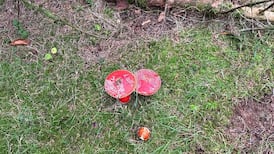Our Thallabawn acre, when we came to it first, was a windswept field on a slope above the sea, densely thistled and waving with tall wild grasses. The soil was a silky loam, well dunged around the ditch in the shelter of the gnarled old hawthorns. I couldn’t wait to be self-reliant on every weedy inch of it.
Almost four decades on, and with great experiments behind us, all has changed. The trees we planted so randomly – 17 sorts at the last count – have grown up amazingly, comforting each other in storms and crowding around the big polytunnel that now commands much of my energy. Trees have brought us thrilling new colours in spring and new nesting birds: goldfinches, mistle thrushes, pioneering rooks. But, like the tall and tangled hawthorn and fuchsia around the ditch, they may have closed out another great pleasure: the abundance and variety of butterflies to dance among the flowers around the house.
Most butterflies need warmth to fly and usually get it by sheltered basking in the sun, not too far off the ground. Most need to find flowering plants for nectar and particular plants to feed their caterpillars: grasses, vetches, nettles and other wild flowers, most of which need good light to thrive. Tall and shady trees are short of butterflies.
There is, indeed, the speckled wood, patrolling so happily in dappled sunlight, and the diminutive purple hairstreak, feeding on honeydew secreted by aphids in the tree canopy – and therefore needing binoculars to spot. There are also the wood whites, smallest of their group and not, in Ireland, bound to woods at all. In fact their actual identity has been fragmenting into subspecies, some of its certainty demanding close genital inspection for which I feel neither equipped nor motivated.
Small, weakly fluttering whites were, indeed, among the big whirl of whites this spring that sent me rushing to net my outdoor cabbages. Other common species arrived on cue in occasional ones and twos: a meadow brown perched here, a small copper darting there. Early speckled woods were markedly few, and only a rare red admiral seemed to be interested in hanging around to find a mate. Not one peacock or small tortoiseshell has appeared, even as the buddleia bloomed for them and blue globe thistles drew the late bumblebees.
Exceptional chill
All this seemed to chime with a clutch of letters from readers bewailing a similar experience and blaming the exceptional chill of spring. But a note of this in Eye on Nature last month brought a prompt email flurry from other readers, recounting quite an opposite experience: buddleias crowded with peacocks and admirals from Kerry to Donegal. In Co Kilkenny Brian Roberts was amazed to see 200 or more peacocks in 20 minutes, crowding the flowering thistles on the trail up Brandon Hill. In Clarecastle, Co Clare, Ted Brooks had more peacocks on his buddleia, along with tortoiseshells and red admirals, than he had seen in 30 years. Even the butterfly websites had enviable sightings to record, almost 40 small tortoiseshells feeding on somebody's privet hedge in Co Antrim at the start of August.
Among the emails was a most helpful commentary from Bob Aldwell, a long-experienced lepidopterist. In a year of strange weather, he confirmed, the early butterflies did poorly, especially the holly blue and orange tip and the early generation of speckled wood and wall brown. The later whites appeared in large numbers, and other species have done well in the best warm and sheltered sites in dunes, woodlands, abandoned quarries and some gardens.
Buddleia bonanza
In July he counted at least 1,500 peacock caterpillars near Timahoe in Co Kildare and a similar number south of Ardara, Co Donegal, all lining up for the later buddleia bonanza. The hibernating small tortoiseshell can vary in its generations, depending on the weather, and this summer has allowed two of them, at least in the south of the island: the children of last winter's hibernators and their grandchildren. Many more small tortoiseshells, Aldwell promises, will have emerged around now. For the moment I am regretting my blitz last winter on thickets of nettles, food plant of peacock and tortoiseshell larvae.
Ireland's two butterfly websites are butterflyireland.com for the Republic and bcni.org for Northern Ireland.
The first offers a fascinating account, by an English visitor, Peter Eeles, of a visit to North Bull Island, in Dublin Bay, where the wild flower devil’s bit scabious grows in abundance. This is the larval food plant of the lovely marsh fritillary butterfly, scarce across so much of Europe and most vividly patterned in Ireland. He saw well over 100 of them, three of which, remarkably, chose the same small leaf on which to lay their eggs. This offered fascinating photographs for his narrative – and promise of hundreds more caterpillars to emerge from their webs next spring.
Dublin really does have the riches of nature on its doorstep.










